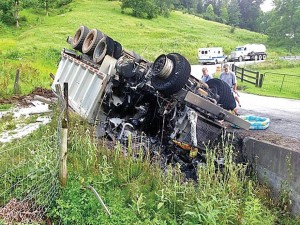Truck overturns, spills drilling wastewater that taints reservoir
From an Article by Laura Arenschield, Columbus Dispatch, March 9, 2016
A truck hauling drilling wastewater overturned in eastern Ohio early this morning, sending thousands of gallons of toxic water into a nearby creek and contaminating a reservoir in Barnesville in Belmont County.
The truck crashed along a curve just after 3 a.m. today, said Barnesville Fire Chief Bob Smith. The driver, Hiley Wogan of Chesterhill, Ohio, was flown by helicopter to a hospital in Columbus, Smith said.
About 5,000 gallons of drilling wastewater spilled into a field, then a creek and finally into one of Barnesville’s three reservoirs.
Smith said the reservoir is closed while the Ohio Environmental Protection Agency tests the water. James Lee, an EPA spokesman, said the agency is investigating the spill.
Smith said the truck is owned by ECM, a brine hauling company with a location in Cambridge, Ohio, not far from Barnesville.
> > > > > > > > > >
Injections of wastewater rise in Ohio despite lull in fracking
From an Article by Laura Arenschield, The Columbus Dispatch, March 7, 2016
The amount of fracking wastewater pumped underground in Ohio increased by more than 15 percent last year, even as shale drilling has slowed nationwide, according to new numbers from the Ohio Department of Natural Resources.
Ohio took in nearly 29 million barrels of fracking wastewater in 2015, according to a Dispatch analysis of department data. That is about 4 million more barrels than in 2014.
Fracking involves pumping a mixture of water, sand and chemicals at high pressure into deep wells to fracture shale formations and free oil and natural gas trapped underground.
The water can be recycled for reuse but eventually must be dumped somewhere. Ohio, which is situated to accept wastewater from states that don’t allow injection waste wells, has more than 200 injection wells. Fewer than 10 have been approved in Pennsylvania, where much of the fracking boom in this part of the country has taken place. West Virginia has about 60.
That means about 13 million barrels a year comes from Pennsylvania and West Virginia, according to the Natural Resources data.
Ohio typically takes more fracking wastewater from outside Ohio than inside. But last year, about 55 percent of the fracking wastewater that ended up in Ohio injection wells came from Ohio, the Dispatch analysis shows.
Wastewater generally travels in tanker trucks on Ohio’s highways until it reaches injection well sites, which are primarily in eastern and southeastern Ohio.
Athens County, for example, took more than 4 million barrels of fracking wastewater in 2015, an increase of 1.1 million barrels, or nearly 40 percent. Most of that wastewater was injected into wells in the eastern part of the county, near the village of Coolville and the unincorporated area of Torch.
Residents there, worried about drinking-water contamination and earthquakes associated with injection wells, have fought unsuccessfully to keep wastewater out.
“Something’s got to give,” said Teresa Mills, program director for the Buckeye Forest Council, an environmental-advocacy group. “Athens County, Coshocton, Guernsey (counties) — these are environmental-justice communities, and we have to stop burdening them.”
Exact numbers about drilling patterns and oil and gas production in Ohio in 2015 are not yet available. Companies were required to report that information to Natural Resources by Feb. 14, said Matt Eiselstein, an agency spokesman. The department will not make the numbers public until it reviews them, he said.
Industry trends nationwide show that drilling slowed in 2015, hampered by low gas and oil prices. A weekly drilling report by the U.S. Energy Information Administration released Feb. 25 showed that the nation’s number of natural-gas rigs was its fewest since 1987.
Jackie Stewart, a spokeswoman for Energy In Depth, an advocacy group for the oil and gas industry, said that even though drilling is down, production per well could be increasing. Drillers also are probably drilling longer horizontal cuts to access oil and gas, she said. That would require more water, which would in turn produce more wastewater.
See also: www.FrackCheckWV.net


{ 1 comment… read it below or add one }
A fracking truck accident has contaminated a reservoir in Ohio.
Most fracking waste water in Ohio is radioactive, isn’t it?
Who is testing the reservoir for radioactivity?
Can the testing agency be believed, or they controlled by the fracking industry – like in most places.
Can we get some independent tests for radioactivity by impartial testing people?
http://www.dispatch.com/content/stories/local/2016/03/09/Fracking-wastewater-shuts-down-reservoir.html